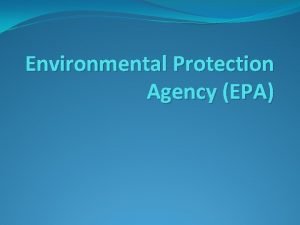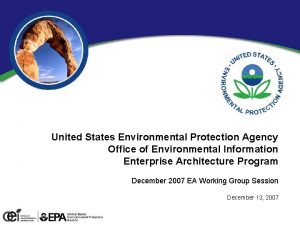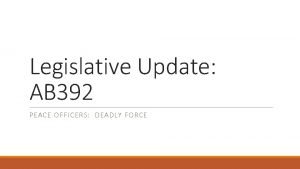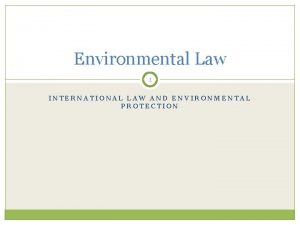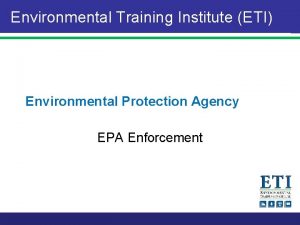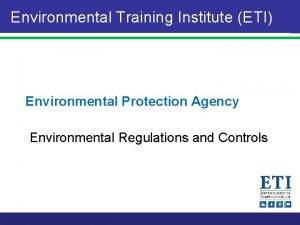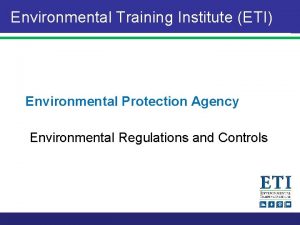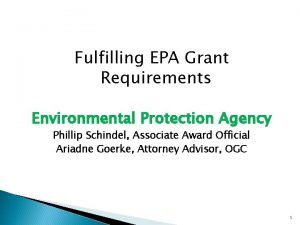Environmental Protection Agency History of the EPA The







- Slides: 7

Environmental Protection Agency

History of the EPA The U. S. Environmental Protection Agency (EPA or sometimes USEPA) is an agency of the United States federal government which was created for the purpose of protecting human health and the environment by writing and enforcing regulations based on laws passed by Congress. The EPA was proposed by President Richard Nixon and began operation on December 2, 1970, after Nixon signed an executive order.

Purpose of the EPA All American's are protected from significant risks to human health and the environment where they live learn and work. National efforts to reduce environmental risk are based on the best available scientific information. Federal laws protecting human health and the environment are enforced fairly and effectively. Environmental protection is an integral consideration in U. S. policies concerning natural resources human health and economic growth energy and transportation agriculture industry and international trade and these factors are similarly considered in establishing environmental policy. All parts of society- communities, individuals, businesses, and state, local and tribal governments – have access to accurate information sufficient to effectively participate in managing human health and environmental risks Environmental protection contributes to making our communities and ecosystems diverse, sustainable and economically productive The United States play an leadership role in working with other nations to protect the global environment.

Contributions How does it contribute to the function of government and what is it’s role within the executive branch… When congress writes an environmental law , they implement it by writing regulations. Often, they will set national standards that states and tribes enforce through their own regulations. If they fail to meet the national standards, they can help them. They also enforce their regulations, and help companies understand the requirements. Governmental authority on environmental issues in the United States is highly fragmented. While the EPA is the most comprehensive environmental agency, its authority on these matters is not absolute. Virtually all of the executive branch's departments have some area of environmental authority. This contributes somewhat to the cost and questionable efficacy of the United States' environmental regulation.

How does it benefit the public ? The EPA benefits the Public directly by Enforcing laws to help protect the environment in which they live, work and learn. EPA and the states generally follow several common approaches in developing and effective compliance and enforcement program: (1) identifying affected facilities; (2) educating the facility operators and providing compliance assistance; (3) monitoring their compliance; (4) selecting and carrying out a timely and appropriate enforcement response when violations are detected; and (5) following up to ensure subsequent compliance by former violators.

Programs Clean Water Act The Clean Water Act (CWA) establishes the basic structure for regulating discharges of pollutants into the waters of the United States and regulating quality standards for surface waters. The basis of the CWA was enacted in 1948 and was called the Federal Water Pollution Control Act, but the Act was significantly reorganized and expanded in 1972. "Clean Water Act" became the Act's common name with amendments in 1972. Under the CWA, EPA has implemented pollution control programs such as setting wastewater standards for industry. We have also set water quality standards for all contaminants in surface waters. The CWA made it unlawful to discharge any pollutant from a point source into navigable waters, unless a permit was obtained. EPA's National Pollutant Discharge Elimination System (NPDES) permit program controls discharges. Point sources are discrete conveyances such as pipes or man -made ditches. Individual homes that are connected to a municipal system, use a septic system, or do not have a surface discharge do not need an NPDES permit; however, industrial, municipal, and other facilities must obtain permits if their discharges go directly to surface waters.

Programs Clean Air Act The Clean Air Act (CAA) is the comprehensive federal law that regulates air emissions from stationary and mobile sources. Among other things, this law authorizes EPA to establish National Ambient Air Quality Standards (NAAQS) to protect public health and public welfare and to regulate emissions of hazardous air pollutants. One of the goals of the Act was to set and achieve NAAQS in every state by 1975 in order to address the public health and welfare risks posed by certain widespread air pollutants. The setting of these pollutant standards was coupled with directing the states to develop state implementation plans (SIPs), applicable to appropriate industrial sources in the state, in order to achieve these standards. The Act was amended in 1977 and 1990 primarily to set new goals (dates) for achieving attainment of NAAQS since many areas of the country had failed to meet the deadlines.
